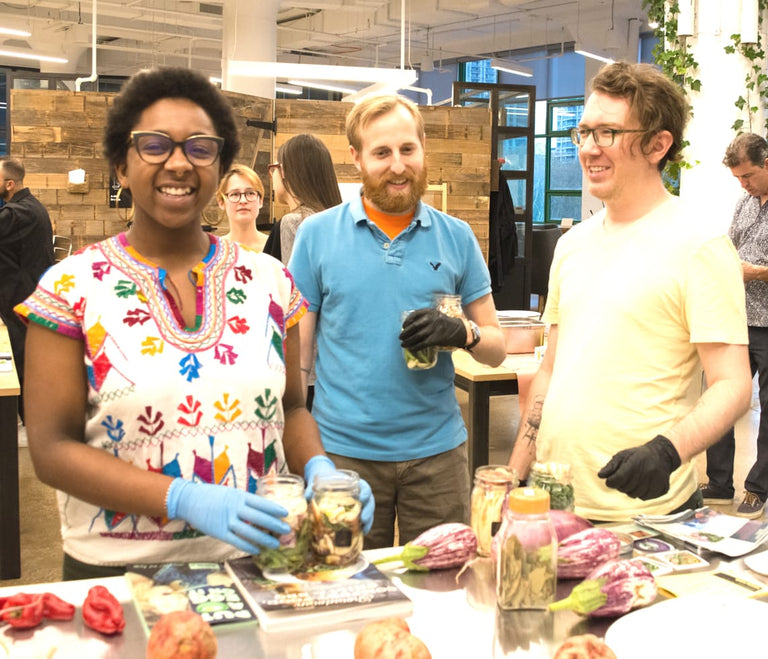Tips for Storing Your Produce
Perishable foods, including fresh fruits, vegetables, eggs, meat, fish, and dairy products will deteriorate rapidly if not stored at proper temperatures and environments. While it’s common knowledge that storing food in the refrigerator will help to reduce spoilage, there are some fruits and vegetables that may be stored quite well out of the refrigerator, if given proper conditions.
It is possible to get the longest storage life for your perishable Local Roots items by following the guidelines in the list that follows (note: this is a list of our current season’s produce):
-
Fresh Herbs:
- Rosemary/Thyme (2 weeks if wrapped lightly in plastic and stored on a shelf in the refrigerator)
- Basil/Parsley/Cilantro (1 week if stems are covered in water. Treat them like a bouquet of flowers but store your bouquet of herbs in your fridge with a bag over the leaves)
- Chives (5 days if stored in the refrigerator with stems wrapped in a paper towel)
-
Leafy Greens:
- Kale or any leafy green (1 week if kept in a plastic bag in a refrigerator drawer)
-
Root Vegetables:
- Radishes (2 weeks + if stored in a plastic bag with a paper towel on a refrigerator shelf)
- Carrots (3 weeks + if kept in a plastic bag in a refrigerator drawer)
- Beets (2 weeks + if kept in a plastic bag on a refrigerator shelf)
- Potatoes (1-2 months when stored in a paper bag in a dark pantry or kept in a plastic bag in a refrigerator drawer)
- Sweet Potatoes (2 weeks when stored in a paper bag in a dark pantry or kept in a plastic bag in a refrigerator drawer)
- Onions (1-2 months if kept unwrapped in a dark pantry or kept in a plastic bag in a refrigerator drawer)
- Mushrooms (3-4 days: paper bag on a refrigerator shelf)
- Eggs (up to 2 weeks: refrigerator)
- Milk (about one week: best stored not on a shelf on the fridge door. See below why)
- Bread (3-5 days if kept on the counter in a sealed plastic bag, cut-side down; 3-5 months if stored in an air-tight plastic bag in the freezer. Pre-slice your bread before putting ).
Click here to see a comprehensive shelf life map of food.
Why You Should Organize Your Produce
There are many reasons suggesting why arranging your pantry can be beneficial. By keeping things organized, you can eliminate food waste by preventing duplicate ingredients and easily find the item you are looking for. In addition to keeping your refrigerator clean (taking time to clean out the drawers with soap and water as often as possible), keeping produce stored separately can help boost its lifespan and keep it from growing mold, and interacting with yeast and other microbes. It’s good practice to keep foods in separate containers or packaging in order to prevent cross-contamination, especially if you are dealing with uncooked items like fish and meat.
Which Foods Make Good Neighbors?
Beyond knowing where things are and reducing the number of foods that go bad, it is important to know which foods to place where in order to keep foods fresh for as long as possible. Turning our attention towards refrigerator storage, it is good to note that packing a refrigerator too tightly can lead to a lack of air circulation, causing foods to turn.
Since door items experience the most heat, it’s a good practice to keep less-perishable items here, like condiments and orange juice (the acidity fights off bad bacteria!). The upper shelves are good for items such as dairy or pre-made foods/leftovers, while the bottom shelves are the coolest part of the fridge (cool air sinks!), and therefore, should have the most perishable foods, like eggs, deli meat, and fish. The crisper drawers in some refrigerators are designed to lock in moisture, keeping leafy greens and lettuce from drying out (you can also stick a wet paper towel in a plastic bag with your veggies to keep them fresh)!
There are certain foods, such as fruits like apples, bananas and cantaloupe, that when stored together, release a colorless musky gas called ethylene, which can cause other foods to ripen more quickly. Try placing other produce you want to ripen faster near these!
Other foods, such as tomatoes, basil, potatoes and avocado, shouldn’t be stored in the refrigerator at all! Foods like bread, garlic, olive oil and honey will dry out and harden or condense and solidify, losing their flavor and taking on odors circulating within the fridge.
Food Rejuvenation
Indeed, with our obsession of food, we’ve found ways to bring it back from the dead if we’ve left it alone for too long. Aside from the practices listed with our seasonal produce above, we like to follow these steps to reverse the signs of aging in our food:
-
Bread: If your bread goes stale, try sticking it cut-side down under the faucet until the entirety of the crust is damp; next, stick it in the oven at 300-325 degrees for 5-10 minutes for a damp loaf, or 10-12 for a super wet loaf. Note that bread that has gone moldy is beyond your control and should be composted. 🙁
- Wilted Salad: Getting that limp lettuce perky again isn’t as hard as one might think! Many fruits and vegetables are made up of eighty to ninety percent water, which means that from the day you buy them, they begin to use up their supply. Once the water evaporates, the cells will begin to shrink, leaving sad soggy leaves in place of the once crunchy ones. By separating the leaves and storing them in layers between lightly dampened paper towels, you can really keep that crunch going on and on. You may also try using conventional kitchen wisdom and squeezing half a lemon on your separated lettuce leaves, or mixing some apple cider vinegar with water and lightly dampening them; the acid encourages cell turnover and production for more water absorption! For the togher-leafed veggies such as kale and chard, you can take the sustainable route by cutting the ends off your greens and sticking them in a jar of water for at least 20 minutes.
- Cucumber: They seem to last forever…until they don’t. If your cucumber is looking a little sad, try chopping off the ends of sad looking pieces and sticking it in some ice water for 30 minutes.
- Cheese: If you notice your cheese is starting to look a little blue (no, not like Stilton), if it’s an aged cheese, mold usually only appears on the surface, so you can cut that stuff right off! If it’s a soft cheese, it’s best to bin it.
- Bananas: The cure to a browning nana is to chop it into pieces that you can stick in the freezer. Try using these to make homemade vegan ice cream or add it to your smoothie in the morning.
-
Milk: For all of your brave ones out there, there is a remedy to stop souring milk in its tracks! This is not to say you shouldn’t toss milk when it churns (into lumps) and smells nasty; only to suggest keeping milk when it’s on the way out. In its last days before expiration, rather than using it in a cereal or drinking it plain, you can try adding it to recipes like baked goods. You can even turn your old milk into cheese!
- Try pouring a half-gallon of milk into a saucepan and bringing it to a boil. Once it reaches a boil, turn the burner to simmer and add 3 Tbsp of vinegar (white distilled vinegar works best), stirring continuously until the consistency is fairly viscous.
- Remove the milk and vinegar from the heat, and prepare a cheesecloth strainer.
- Pour the liquid into the cheesecloth and squeeze the majority of the liquid until you are left with the firmly curdled milk. You can then form the cheese into whatever shape you want and store it in the refrigerator until it’s cool to cut it!
When thinking about our foods’ lifespan we typically go no further than thinking about the time it spends in our homes and tummies. Not only is it important to think about the journey our food makes, and who it comes from, but also how we manage to keep it from going bad so we reduce waste! Don’t forget you can always make a veggie scrap broth (link to image on our website) with produce you just can’t revive.
Article by blog contributor, Rebecca Stone
Photo courtesy of Domestic Soul
Rather have a taste first?
Local Roots Experiences are fun, pop-up events where we bring the farm to you!

Become a Harvest Club Pick Up Location
Are you a NY based cafe, bar, or neighborhood business? Become a Harvest Club pick up location and have community members come to your establishment each week to pick up their Local Roots harvest.
Top






